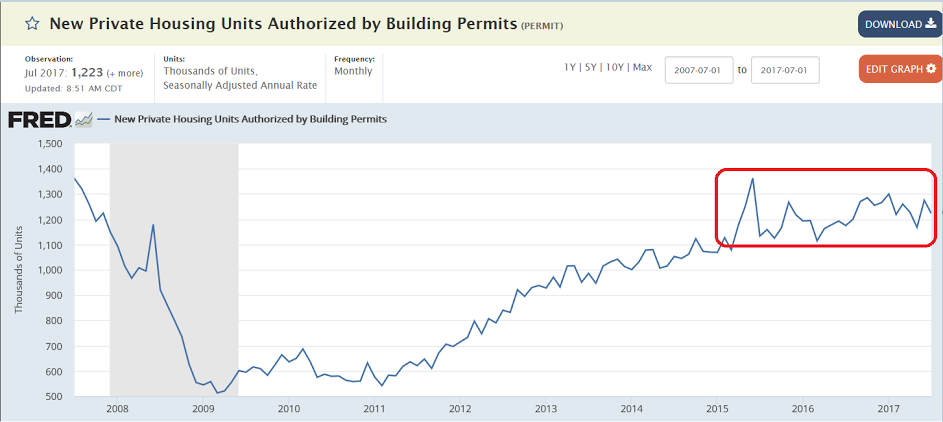Lower than expected, and, as always starts are ultimately determined by permits, which have been slowing as per the chart, which also reflects the deceleration in mortgage lending over the last 6 months: Highlights Housing starts couldn’t hold the 1.200 million annualized line in July, falling to a lower-than-expected 1.155 million. The rate is now back to the weakness of March and April in what may be emerging as a declining trend this year. Permits also fell but are holding over 1.200 million, at 1.223 million which is down from June’s 1.275 million but with this trend holding up better. The swing factor is multi-family units, the smallest of the report’s two components but, after a run of heavy building earlier this year, are now in retreat. Multi-family starts fell to
Topics:
WARREN MOSLER considers the following as important: Uncategorized
This could be interesting, too:
tom writes The Ukraine war and Europe’s deepening march of folly
Stavros Mavroudeas writes CfP of Marxist Macroeconomic Modelling workgroup – 18th WAPE Forum, Istanbul August 6-8, 2025
Lars Pålsson Syll writes The pretence-of-knowledge syndrome
Dean Baker writes Crypto and Donald Trump’s strategic baseball card reserve
Lower than expected, and, as always starts are ultimately determined by permits, which have been slowing as per the chart, which also reflects the deceleration in mortgage lending over the last 6 months:

Highlights
Housing starts couldn’t hold the 1.200 million annualized line in July, falling to a lower-than-expected 1.155 million. The rate is now back to the weakness of March and April in what may be emerging as a declining trend this year. Permits also fell but are holding over 1.200 million, at 1.223 million which is down from June’s 1.275 million but with this trend holding up better.
The swing factor is multi-family units, the smallest of the report’s two components but, after a run of heavy building earlier this year, are now in retreat. Multi-family starts fell to a 299,000 rate in July from June’s 353,000 and are down 34 percent year-on-year. Multi-family permits, at 412,000, are down nearly 10 percent.
Single-family data are holding steady with starts at 856,000 for an 11 percent yearly gain and permits at 811,000 and a 13 percent gain.
Putting all the pieces together: starts are down 5.6 year-on-year in weakness offset by permits which are up 4.1 percent. Permits are the forward looking indication in this report and today’s news, despite July weakness and general volatility in the data, is good. The housing sector, even with starts being soft, looks to be a contributor to the second-half economy.

Psychologists surveyed hundreds of alt-right supporters. The results are unsettling.
Aug 16 (CNBC) — Kteily, the co-author on this paper, pioneered this new and disturbing way to measure dehumanization — the tendency to see others as being less than human. He simply shows study participants the following (scientifically inaccurate) image of a human ancestor slowly learning how to stand on two legs and become fully human.
Participants are asked to rate where certain groups fall on this scale from 0 to 100. Zero is not human at all; 100 is fully human.
On average, alt-righters saw other groups as hunched-over proto-humans.
On average, they rated Muslims at a 55.4 (again, out of 100), Democrats at 60.4, black people at 64.7, Mexicans at 67.7, journalists at 58.6, Jews at 73, and feminists at 57. These groups appear as subhumans to those taking the survey. And what about white people? They were scored at a noble 91.8.
The comparison group, on the other hand, scored all these groups in the 80s or 90s on average. (In science terms, the alt-righters were nearly a full standard deviation more extreme in their responses than the comparison group.)
